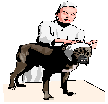

|
"Adopt an Animal Gain a Friend" |
|
|
|
|
![]()
Pet Health
|
How to keep your pet healthy Your pet depends on you to keep him safe and healthy. It is the least you can do in return for all of the love and companionship that he gives you. Keeping your little buddy healthy and safe will help him be a great companion to you for as long as possible. There are a few simple things that you can do to keep your pet healthy and safe: 1. Keep your cat indoors and your dog safely fenced or on a leash at all times. A pet that is roaming freely outdoors is exposed to many risks, many of which can be deadly. These include: a. Being hit by a car b. Poisoning by chemicals such as lawn chemicals, antifreeze, rat poisons, and others c. Contracting diseases such as rabies, feline leukemia, feline AIDS (FIV) and feline infectious peritonitis (FIP) d. Abuse by humans e. Getting lost f. Being stolen (possibly for the purpose of being sold to an animal experimentation lab) g.
Being injured or killed by outdoor
predators or dogs
2. Yearly veterinary visits. Routine veterinary visits may be able to pick up signs of illness before they become serious. Also, your veterinarian will be able to review with you the things that you need to be doing at home to prevent illness. Of course, keeping your little buddy up-to-date on his vaccinations as recommended by your veterinarian is a crucial part of good preventative care. 3. Spay and neuter all of your companion animals. Most people know that spaying and neutering is the single most important way to decrease the pet overpopulation problem which results in the euthanasia of millions of adoptable animals each year. However, many people do not know that spaying and neutering can prevent many serious, and often deadly, diseases in their pets. Females who are spayed are free of the risk of uterine and ovarian cancer, and have a decreased risk of mammary cancer. Males who are neutered are spared the risk of testicular cancer and have a decreased risk of prostate problems. In addition, sterilized animals will roam and fight less, thus preventing injuries. Animals who are spayed and neutered will have a significantly decreased risk of some behavioral problems, such as spraying, which could ultimately result in their being rendered homeless in a shelter and awaiting euthanasia. 4. All dogs should take some type of socialization/training class(es). A dog that has learned how to follow commands can be kept safer than one who has not learned what different commands mean. A dog that is running toward traffic, or getting too close to a hot stove, a heater or a dangerous animal will, if trained, stop when told to do so, thereby staying safe. An educated dog who knows what “drop it” or “leave it alone” means can be stopped from swallowing dangerous objects. 5. Your pet should wear some type of identification at all times. Every pet in your household should wear an identification collar and tag at all times. Alternatively, identification microchips can be easily inserted under your pet’s skin by a veterinarian. Even if your cat never goes outdoors, she should always have some sort of identification. Cats can easily slip out the door, detected or undetected, and will be much harder to locate if she is not wearing any identification. 6. Feed your little buddy nutritious food. Check with your veterinarian regarding the best diet to feed your companion animals. You should feed them the highest quality food that you can afford in order to keep them as healthy as possible. But don’t overdo it. Too much food will lead to obesity. 7. Be sure that your companion animal gets plenty of exercise. This will help keep him fit and healthy and will help to prevent obesity. 8. Isolate new pets from household pets. You should keep any new additions to your animal family separated from household animals until you are sure that the new member has no infectious diseases. In general, new animals should be kept away from other household animals for 2-3 weeks. 9. Protect your pet from common household dangers. There are many things around the house that can prove dangerous, and even deadly, to your companion animals. This list is taken from The Humane Society of the United States (http://www.hsus.org/ace/11840). Antifreeze Antifreeze that contains ethylene glycol has a sweet taste that attracts animals, but is deadly if consumed in even small quantities; one teaspoon can kill a seven-pound cat. The HSUS recommends that pet owners use a safe antifreeze in their vehicles. Look for antifreeze that contains propylene glycol, which is safe if ingested by animals in small amounts. Whichever you use, always keep the antifreeze where your pets cannot get into it. Lawn and garden chemicals Chemicals used on lawns and gardens, such as fertilizer and plant food, can be fatal to a pet. Remember to keep such chemicals where your pets cannot get into them. Also, keep pets off of lawns that have had these chemicals recently applied. Chocolate Chocolate is poisonous to dogs, cats, and ferrets. De-icing salts De-icing salts used to melt snow and ice are paw irritants that can be poisonous if licked. Paws should be washed and dried as soon as the animal comes in from the snow. Other options include doggie boots with Velcro straps. Of course, keeping cats indoors will eliminate their exposures to these dangerous chemicals. Flea
and tick products
Some of the over-the-counter flea and
tick remedies may be toxic to companion
animals.
Prescription flea and tick control
products are much safer and more effective.
Pet owners should never use any
product without first consulting a
veterinarian. Human medications Some human medications, including aspirin, Tylenol, ibuprofen (Advil), cold medicines, anti-cancer drugs, antidepressants, vitamins and diet pills, among others, can be toxic and potentially deadly to animals. Keep all medication containers, ointments, and creams closed and in a safe place where your companion animals cannot get into them and cannot chew through the tubes. Be vigilant about finding and safely disposing of any dropped pills. Foods Chicken bones can easily shatter and can choke a cat or dog. Other human foods to keep away from pets include onions and onion powder; alcoholic drinks; yeast dough; coffee grounds and beans; salt; macadamia nuts; tomato, potato, and rhubarb leaves and stems; avocados (toxic to birds, mice, rabbits, horses, cattle and dairy goats); and anything with mold growing on it. Household plants Poisonous household plants include azaleas, geraniums, dieffenbachia (dumb cane), mistletoe, philodendrons and poinsettia, among others. Rawhide doggie chews Rawhide doggie chews may be contaminated with salmonella, which can infect pets and humans. These kind of chews can also pose a choking hazard as well and, therefore, should only be offered to a pet with supervision. String, yard, rubberbands, and dental floss All of these products are easy to swallow and can cause intestinal blockages or strangulation. If you do play with your pet using any of these things, you should remember to keep them stored away safely whenever you are not supervising the play session. Toys with removable parts Toys that have small pieces which can come off – like squeaky toys or stuffed animals with plastic eyes – can pose a choking hazard to animals. Remove from the toys any small pieces which could come off and throw them away in a place where your pets (and small children) cannot get to them. Drapery cords You should keep entire drapery cords tied up above the window. Cats can strangle themselves in cords that are left dangling down. Dryers
Dryer doors should always be kept
shut. Cats
like to explore small areas, especially ones
with soft clothes in them, and may be killed
if someone unknowingly shuts them in the
dryer and starts it. If all of your precautions have failed and you believe that your pet may have been poisoned, contact your veterinarian or emergency veterinary clinic immediately. Signs of poisoning can include such things as listlessness, abdominal pain, vomiting, diarrhea, muscle tremors, lack of coordination and fever. For further information about common household pet dangers: 1.
The American Veterinary Medicine
Association publishes Pet
Owner’s Guide
to Common Small Animal Poisons. 2. The HSUS, in conjunction with the American Red Cross, publishes a book entitled Pet First Aid: Cats and Dogs. 3. The ASPCA Animal Poison Control Center operates a hotline 24 hours a day, seven days a week at 888-426-4435 or 900-680-0000 for a fee of $45 per case. Signs of Illness In Your Pet It is often difficult to tell when your companion animal is ill. Pets frequently will hide signs of illness and pain from their humans. Sometimes even subtle signs can be signs of serious illness. When in doubt, take your little buddy to the veterinarian. Signs of possible illness include: a. weight loss b. misses more than one meal c. urinating or defecating in inappropriate places d. stops using the litter box e. change in behavior f. less active g. cough h. drinking or urinating more than usual i. any new lumps or skin lesions j. diarrhea k. vomiting l. hides for more than a day m. stops grooming o. blood in the stool p. changes his routine or looses interest in his favorite game |
![]()
![]()
![]()
Copyright © [2003] [Little Buddies Adoption and Humane Society].


